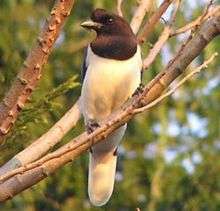Curl-crested jay
| Curl-crested jay | |
|---|---|
| | |
| Male | |
| Scientific classification | |
| Kingdom: | Animalia |
| Phylum: | Chordata |
| Class: | Aves |
| Order: | Passeriformes |
| Family: | Corvidae |
| Genus: | Cyanocorax |
| Species: | C. cristatellus |
| Binomial name | |
| Cyanocorax cristatellus Temminck, 1823 | |
The curl-crested jay (Cyanocorax cristatellus) is a jay from South America.

This New World jay is a beautiful and large (35 cm/14 in overall) bird with predominantly dark blue back, an almost black head and neck, and snow-white chest and underparts. They have a pronounced curled crest rising from just behind the beak; the crest is on average larger in males, but the sexes are generally quite similar.
The voice is a loud, gray, graa, gray-gray-gray, sometimes repeated 8-10 times.[2] They sound similar to crow.
Curl-crested jays are native to the cerrados of central and southern and the caatinga of northeastern Brazil. In the southeast Amazon Basin, curl-crested jay ranges into the upstream headwater regions adjacent to the northwestern cerrado. In the west, the extreme headwaters of the west-flowing Guaporé River on the Brazil-Bolivia are home. For the southeast Amazon, the north-flowing rivers that limit the range are the Tapajós on the west, the Xingu River, then the adjacent drainage to the east, the Araguaia-Tocantins River system. The range continues easterly and southerly through the cerrado. The range on the river systems is only the upstream half of the drainages. They can also be found in extreme northern Paraguay. Altogether, they are limited by the extent of habitat, but wherever this is suitable, they may not be rare. For example, they are the most commonly seen corvid in the Serra do Cipó National Park.[3]
They live in groups of from 6 to 12 individuals, moving from food source to food source during the day. They leave a lookout nearby to keep watch for predators.[4] This bird is a generalist, eating almost anything, including eggs and nestlings of other birds, insects, arthropods, and small vertebrates like geckos. It also likes palm nuts and is particularly fond of the seeds of the native Inga laurina and the fruits of the introduced umbrella tree (Schefflera actinophylla). Curl-crested jays have even been observed spending the early morning in a pequi tree (Caryocar brasiliense) where they fed on nectar, and perhaps also on invertebrates which had visited the mainly night-blooming flowers of this plant.[5]
This jay is not considered a threatened species by the IUCN,[6] and in fact they are at present expanding their range. However, range expansions may only be temporary and populations may eventually disappear from formerly settled locations again.[7]
Footnotes
- ↑ BirdLife International (2012). "Cyanocorax cristatellus". IUCN Red List of Threatened Species. Version 2013.2. International Union for Conservation of Nature. Retrieved 26 November 2013.
- ↑ Sick (1993)
- ↑ Rodrigues et al. (2005)
- ↑ Ragusa-Netto (2000)
- ↑ Melo (2001)
- ↑ BLI (2008)
- ↑ Faria et al. (2006)
References
- Faria, Christiana M.A.; Rodrigues, Marcos; do Amaral, Frederico Q.; Módena, Érica & Fernandes, Alexandre M. (2006): Aves de um fragmento de Mata Atlântica no alto Rio Doce, Minas Gerais: colonização e extinção [The birds of an Atlantic Forest fragment at upper Rio Doce valley, Minas Gerais, southeastern Brazil: colonization and extinction]. Revista Brasileira de Zoologia 23(4): 1217-1230 [Portuguese with English abstract]. doi:10.1590/S0101-81752006000400032 PDF fulltext
- Lorenzi, Harri & de Souza, H.M. (2001): Plantas Ornamentais no Brasil ["Ornamental plants from Brazil"]. Instituto Plantarum, Nova Odessa, São Paulo, Brazil [in Portuguese].
- Lorenzi, Harri (2002): Arvores Brasileiras: Manual de identificação e cultivo de plantas arbóreas do Brasil ["Brazilian trees: Identification and cultivation manual for Brazilian arboraceous plants"]. Instituto Plantarum, Nova Odessa, São Paulo, Brazil [in Portuguese].
- Melo, C. (2001): Diurnal bird visiting of Caryocar brasiliense Camb. in Central Brazil. Revista Brasileira de Biologia 61(2): 311-316 [with Portuguese abstract]. doi:10.1590/S0034-71082001000200014 PDF fulltext
- Ragusa-Netto, J. (2000): Raptors and "campo-cerrado" bird mixed flock led by Cypsnagra hirundinacea (Emberizidae: Thraupinae). Revista Brasileira de Biologia 60(3): 461-467 [English with Portuguese abstract]. doi:10.1590/S0034-71082000000300011 PDF fulltext
- Ridgely, Robert S.; Tudor, Guy & Brown, William L. (1989): The Birds of South America (Vol.1: The oscine passerines). University of Texas Press, Austin. ISBN 0-19-857217-4
- Rodrigues, Marcos; Carrara, Lucas A.; Faria, Luciene P. & Gomes, Henrique B. (2005): Aves do Parque Nacional da Serra do Cipó: o Vale do Rio Cipó, Minas Gerais, Brasil [The birds of 'Parque Nacional da Serra do Cipó': the Rio Cipó valley, Minas Gerais, Brazil]. Revista Brasileira de Zoologia 22(2): 326–338 [Portuguese with English abstract]. doi:10.1590/S0101-81752005000200005 PDF fulltext
- Sick, Helmut (1993): Birds of Brazil – A Natural History. Princeton University Press, Princeton. ISBN 0-691-08569-2
- Sigrist, T. (2006): Birds of Brazil – An Artistic View. São Paulo. ISBN 85-905074-1-6
External links
| Wikimedia Commons has media related to Cyanocorax cristatellus. |
- Curl-crested jay videos on the Internet Bird Collection
- Curl-crested jay photo gallery VIREO
- Photo-High Res; Article pbase
- Photo-High Res; Article geometer–Photos from Brazil
